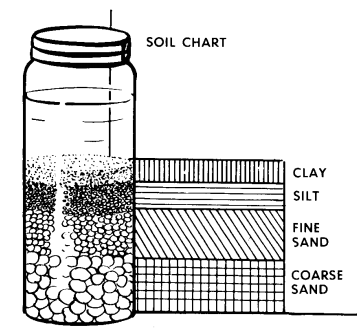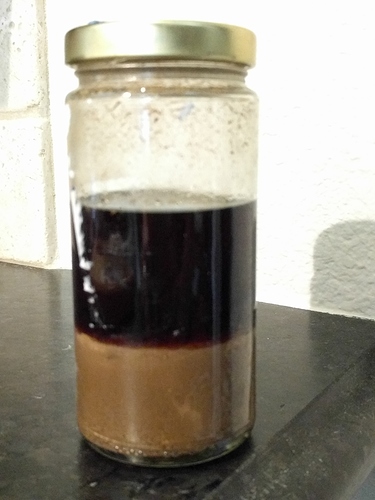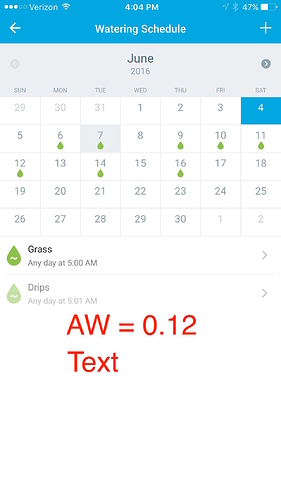Looking for some help. My mason jar test is complete but it settled unevenly. Any ideas as to where i should measure?
@Modawg2k Maybe right through the middle of that diagonal slope ? It seems like it would be fairly close to the average.
If i’m doing my observations correct with averaging out the two sides, it looks like my soil is ~55% sand, 35% clay, 10% silt. On the triangle graph they have it’s roughly “sandy clay loam”.
@Modawg2k Which demarcation is for which type ? I found these instructions in another post, but I can’t quite make out the correlation of the drawing to your numbers.
Did you take the sand measurement after 1 minute and the silt after 2 hours ? That part of the instructions seem a bit odd to me.

The bottom is corse sand, the 2nd is the fine sand, the third right above it is the silt, the 4th is clay, and i marked the top of the water accidentally.
Yeah those directions didn’t make sense. I just let it sit for almost 3 days then took the markings. Now I just need to figure out where sandy clay loam falls into things
@Modawg2k Found this at http://www.rainbird.com/homeowner/education/soiltype.htm
It seems to me that the closest Rachio setting is Clay Loam. If you’re still currently on Sandy Loam the intake rate would get cut in half, from 0.4 in/hr to 0.2 in/hr. Could the Web Soil Survey be that far off ?
My wife is going to roll her eyes when I ask her for a mason jar.
I will say that I feel like the top part of the soil is still damp when the iro is set to go off again with sandy loam. Isn’t the idea for the top part to be somewhat dry with the roots still somewhat wet?
Seems fair to expect that. Maybe the Rachio guys can comment ?
I’m also curious as to whether anyone else has experience with comparing the mason jar test to the Web Soil Survey site ?
@Modawg2k I’m wondering if you decided to change your soil type from the Web Soil Survey recommendation of Sandy Loam to something else? It seems my Mason Jar test it’s like yours, although it seems like I just have unsettled, murky water at the top that doesn’t want to settle! It seems it’s going to evaporate before it settles.
Interesting. Based off the percentages I got, I tried out going up one decimal from Sandy Loam (0.12) to 0.13. My only reasoning for that is that Clay Loam is 0.2, so obviously the more clay in the soil, the higher the AW would go. Below are 2 pics based off AW 0.12 (Sandy Loam) and my hybrid 0.13.
@Modawg2k. Thanks for the update. I hadn’t thought of playing around with the AW number. That’s a good way to find a compromise. I need to find some time to sit down and play around with my setup. I want to try the new ability to change crop coefficient for my garden, and pay more with soil types. I’m afraid to play too much right now with this heat though. Our thermostat is reading 117F. Not much different for you I’m sure.
If I remember right, you are further south than me so I think it’s hotter for you guys. It’s only 114 here, so we are opening up the windows to get some fresh air in the house 
@azdavidr So I was doing a little digging into my dirt on my lawn and the soil just seems so compact and clay-like to me to be considered more sandy than anything else. If you look at the picture, on the side of where I dug in is super smooth. The grass hasn’t been watered since yesterday morning, and is scheduled to water tomorrow morning. I wonder if I should bump up my AW even more to be more clay-like.
@Modawg2k I completely agree with regards to the texture and appearance of more clay than not, BUT, here’s my recent experience. I bumped up to Clay Loam a while back. That AW was 0.2. Earlier this week, I noticed that my Bermuda wasn’t looking so great. I also called a lab in town that does soil analysis, and the woman I spoke to said that the vast majority of Arizona has Sandy Loam. She quoted 85% of either the state or the Phoenix area, I don’t remember which, as having Sandy Loam. So I’m based on those two data points, and the fact that the web soil survey says Sandy Loam, I’m sticking to an AW of 0.13 for now. You might try a suggestion @plainsane gave me a while back to push your MAD up a tad. It will decrease the frequency and encourage root growth. Once I see a sufficiently green lawn I plan to try that out!
Great information. I’m curious what good root growth looks like. Every time I dig into my soil I don’t seem to find many roots. Especially not more than a couple inches down even though I water for 9 inches.
@Modawg2k I dug in a bunch when I was changing out heads. The deepest I measured was ~ 7 inches, but the ones I saw extending that deeply were certainly fewer than those that were higher up. I’d say I had a greater density through about 4-5 inches if I remember right, but definitely had some down to 6 and fewer still to 7.
Maybe what you’re seeing is the rhizomes, which if I read these articles properly is different from the roots.
http://ipm.ucanr.edu/PMG/PESTNOTES/pn7453.html
The 1st article is actually about getting rid of Bermuda, but note the description of stolons and rhizomes, then this comment:
"Depth
If you can feel the difference when you are under the mat of sod. Cutting into sod is tough, Beneath should be easier, surprising easier. You will probably see horse hair type fibers still sticking up. These are the roots."
This article talks about watering 8-10": http://southwestgardener.com/summer-lawn-care/
There’s probably more articles out there, and some probably conflict these. I wish it were all more obvious!




